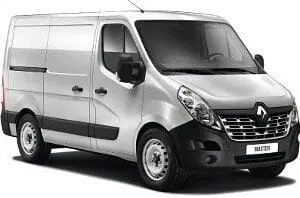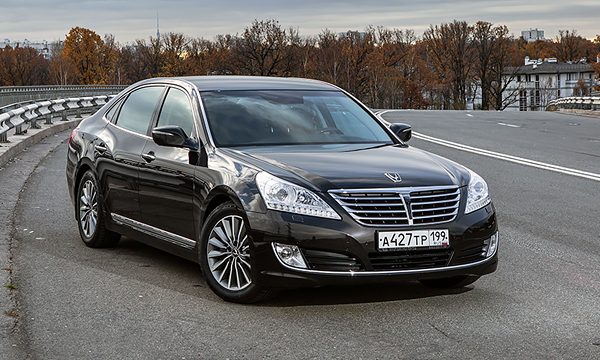
Test drive Hyundai Equus
The most shiny piece of wood, an imaginary VIP passenger and other things that excite the most about Equus ...
In an ideal world, we could buy a hot hatch for $ 16, look closely at Japanese crossovers, and choose between the Opel Astra and the Honda Civic. Volkswagen Scirocco, Chevrolet Cruze and Nissan Teana of Russian assembly remained in that reality. Over the past year, the balance of power in the Russian market has changed dramatically: a budget sedan in a good configuration can no longer be bought for less than $ 019, and the cost of a large crossover approached the price of a two-room apartment in Yuzhnoye Butovo. The price of executive sedans has risen even more - it is no longer possible to order a car in a medium modification up to $ 9. But there are exceptions - for example, Hyundai Equus added about $ 344 over the year, which is very little by the segment's standards, and now competes almost on an equal footing with models of European brands. We drove the Equus and found out why the car has not yet become a leader in its class.
The oncoming Equus sported a Maserati-style trident decal on the C-pillar. Why not Mercedes-Benz or Maybach, for example? Korean premium still lacks self-identity. But most of the road has been covered: Hyundai has built a big black luxury sedan, even if its name and nameplate are still exotic. This is probably why so many people buy a metal winged figurine for the hood, which is uniquely related to the world of big money.
Familiar motifs in the appearance of the Equus indicate that its creators have carefully studied the experience of European and Japanese class leaders. And they were able to recreate the spirit of conservative solid luxury inside: leather, wood, metal, large soft chairs. Management of various functions is entrusted to the good old buttons and knobs. And from the newfangled - perhaps the unfixed joystick of the ZF "automatic", as on BMW and Maserati, and a virtual dashboard.
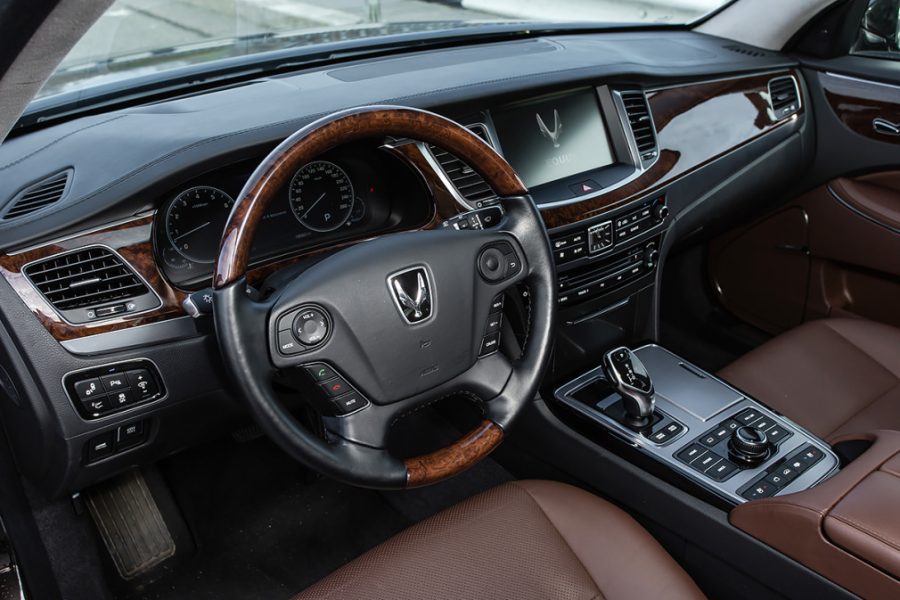
The Hyundai Equus is built on a platform that has been developed specifically for this model. The rear-wheel drive sedan can be equipped with two types of suspension. The basic version is a spring-loaded design with two wishbones on the front axle and three wishbones on the rear. In top-end versions, Equus can be ordered with air suspension, which automatically changes the level of ground clearance depending on the speed. The distribution along the axles of the sedan is 50:50.
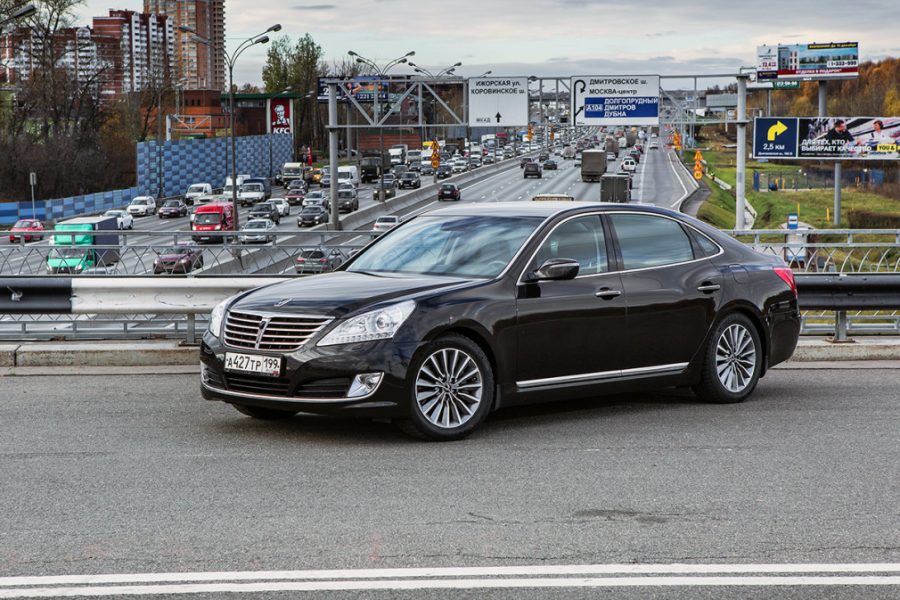
The graphics of the multimedia system are beautiful, but there is no navigation here, and the control of the radio stations was unexpectedly confusing. Cameras help out great when parking, but only during the day, and in the dark the picture fades.
The V6 powertrain, despite the fact that this is the weakest option possible, is unexpectedly high-spirited and gluttonous. More than three hundred horses are enough to go fast. The sedan does not like haste and in sport mode it becomes only a little tougher. When cornering more abruptly, the car responds with a deep roll, and the steering wheel unexpectedly rests during fast rotation. In addition, Nexxen tires are too budgetary choice for a premium sedan - they don't have a grip and start to squeak too early.
Therefore, the Ekus should be driven smoothly, without haste, so as not to disturb an imaginary VIP passenger. However, this is an almost impossible task: the air suspension carefully carries the huge sedan over the ground, not noticing the tram tracks, joints, pits and speed bumps. On a slippery road, a powerful car helps out a special transmission mode, and if necessary, air springs allow you to raise the sedan off the ground. At the same time, Equus, with all its advantages, is cheaper than its closest competitors. Perhaps he is not so eminent, but this is a matter of time.
Equus is based on the same architecture as the Genesis, but unlike it, it is sold only with rear wheel drive. It is expected that the sedan will be equipped with an all-wheel drive transmission after restyling. We are talking about the HTRAC system, which has two modes of operation: standard (electronics distributes torque in automatic mode, and the proportions depend on road conditions) and sport (the front axle is connected at the start to avoid slipping, and in long corners to improve handling) ...
There are two engines available for Equus: a 6 liter V3,8 (334 hp) and a 8 liter V5,0 (430 horsepower). Both motors are paired only with an 8-speed "automatic". From standstill to 100 km / h, the base sedan accelerates in 6,9 seconds, and the fastest version in 5,8 seconds. The maximum speed in both cases is electronically limited to 250 km per hour.
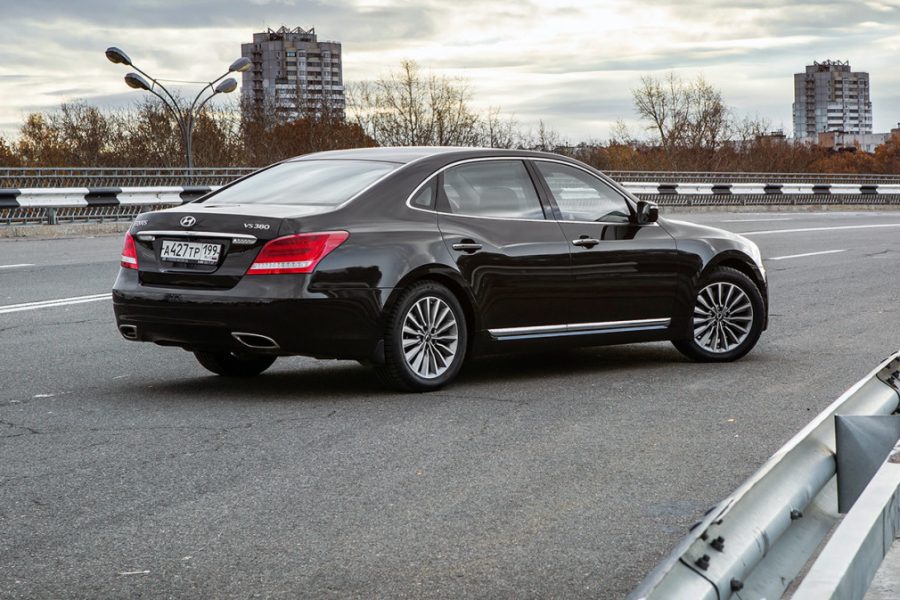
Equus looks eerily familiar. Like your friend who recently underwent plastic surgery. On the one hand, this is definitely her, on the other, you understand that something in her has become completely different. On the outside, this Hyundai looks like the previous Mercedes-Benz S-Class, which stopped going to the gym, but did not give up on protein shakes.
I personally like this car. It's big, loud and cute, although I usually like more aggressive models. Here, the designers and programmers clearly decided to foresee all possible driving situations and made the sedan snap at the driver if he thinks that he is making the wrong choice. You can fall in love with Equus. The main thing is to understand that he does not need to resist and just let the electronics do everything except the steering wheel movements.
The basic version of the Hyundai Equus, excluding promotions and special offers, will cost at least $ 45. The starting configuration, called Luxury, already has 589-inch alloy wheels, leather interior, bi-xenon optics, three-zone climate control, keyless entry system, electric boot lid, heated rear seats, rear view camera and DVD.
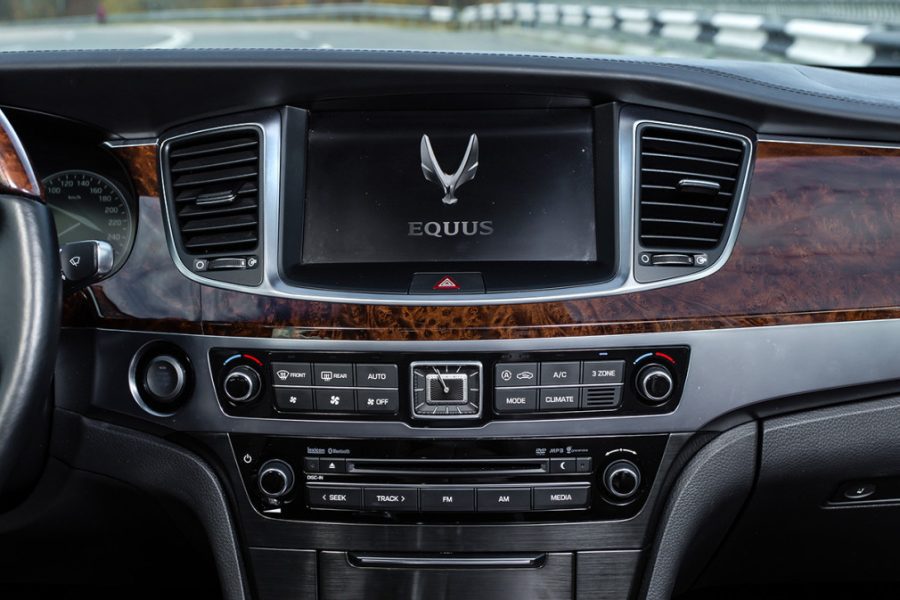
When there is free space on the road, the Equus goes fast. I had a 3,8-liter version with a V6 in my test, and it accelerated very confidently. There is also a 5,0-liter variant, which must be just a rocket. When I say "fast" about our version, I mean dynamically for its size and class. The car is not slow at all and is capable of surprising BMW and Audi - at least once at RBK they gave me a car that was not ashamed at the traffic lights. In this "Korean" there is an opportunity to play with the choice of driving modes and gear shifting, but, again, the car reads the driver's wishes only from the force of pressing the gas pedal and steering movements.
Alas, the creators made two or three mistakes when designing the car. Its main task is to comfortably transport a passenger and a driver from one point to another. Someone had to explain this to those involved with the Equus suspension. It's too tough for a premium sedan, and it can crush your spine with the knees of people in the back.
There are even more problems on the second row. The Koreans, apparently, have their own idea of a comfortable seat position: no manipulations with the very beautiful seat control buttons allowed me to adjust it so that I could at least feel a little comfortable. The final blow for me is the steering wheel - the most shiny piece of wood in the world. Perhaps Hyundai worked in conjunction with a manufacturer of gloves for the tightest grip on the steering wheel: without them, driving a car is a lottery.
The next level of Elite equipment will cost $ 49. Here, air suspension, LED fog lights, electric rear seats, ventilation for all seats and a navigation system are added to the specified equipment. The top trim level for the Equus with a 327-liter engine is called the Elite Plus and starts at $ 3,8. The package of options here additionally includes a surround view system, a multimedia system with an enlarged display and two monitors for the rear passengers.
The sedan with a 5,0-liter engine is available for order only in one configuration - Royal. Such a car will cost $ 57. Here, in addition to the options provided in the Elite Plus version, there are all-LED optics, adaptive cruise control, a right-hand rear ottoman seat, sunroof and 471-inch alloy wheels.
Russian officials and deputies should be extremely grateful to Hyundai. Equus is the easiest way for them to drive a high-quality, roomy car with all modern features. For example, when the Krasnoyarsk center for standardization, metrology and certification was not allowed to buy an expensive Volkswagen Phaeton, they posted an application for the Hyundai Equus on the public procurement website, which did not cause a wave of dissatisfaction.
Hyundai Equus, which we had in the editorial office, is a cool car, high-quality and very comfortable. But it is impossible to compare it with the new Mercedes S-Class - the class leader in sales. W222 is still a car as if from another Galaxy.
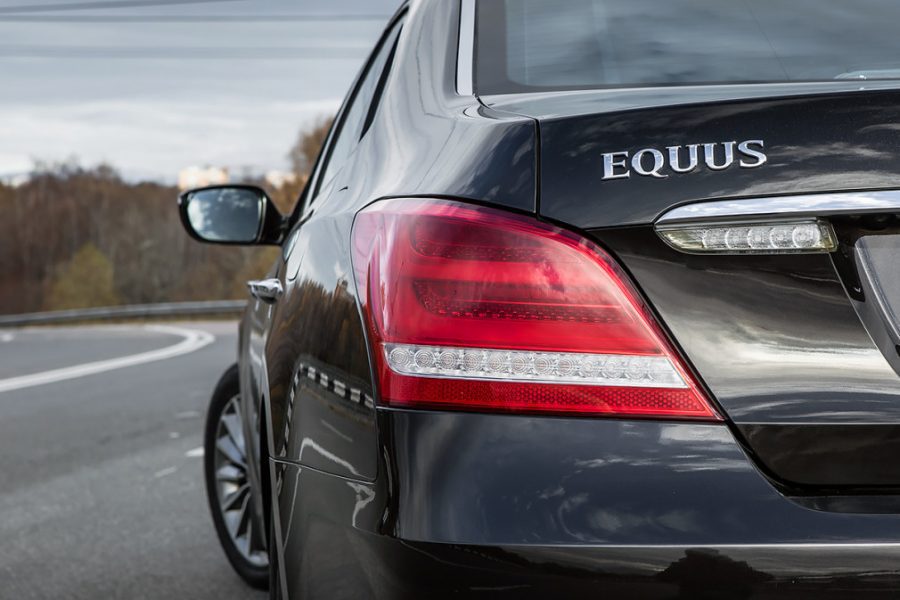
The first generation Equus was introduced in 1999. The large executive sedan, which has been billed as a competitor to the Mercedes S-Class, was developed by Hyundai and Mitsubishi. The Japanese brand sold its Proudia model in parallel, which practically did not differ from the Equus. There were two engines for front-wheel drive models: a 6-liter V3,5 and a 4,5-liter V8. In 2003, the Korean sedan underwent the first and only restyling, and in Mitsubishi, a few months later, Proudia was discontinued.
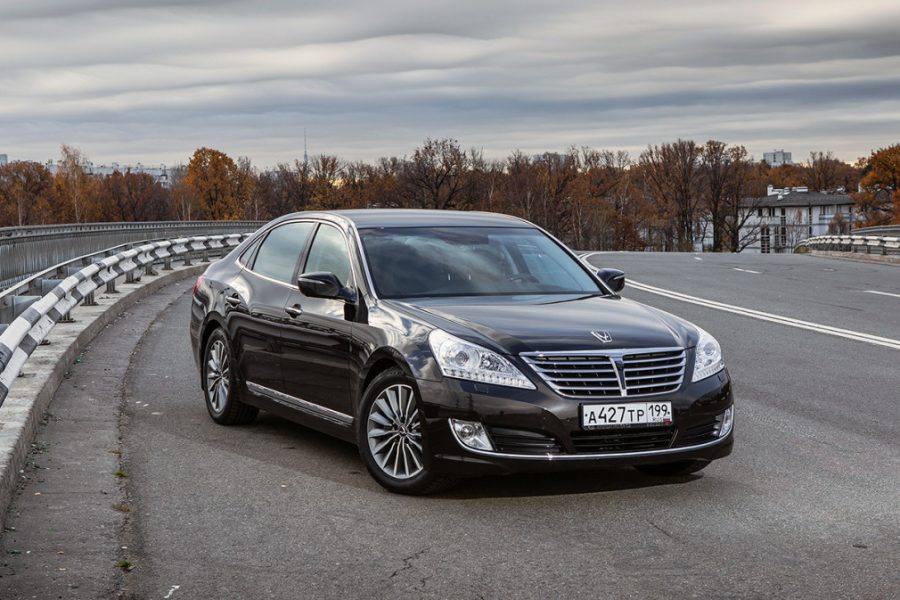
Compared to its predecessor, the Equus is much better. The interior has become more impressive: there is leather, wood, aluminum, excellent screen graphics and a gearbox joystick, like on a BMW. I switched to an Equus from a Lexus NX200 and the Korean seemed scorchingly fast to me. In the evening I looked at the STS - it turned out that this is the slowest option of all that are sold on our market. Here 334 hp. and 6,9 seconds to 100 km / h - the result is more than good, but the 5,0-liter version accelerates even faster.
If the crisis drags on, Equus could seriously increase its sales and become a real threat to the German troika. Especially when consumers realize that, at least in terms of comfort, the difference between these cars is not so significant.
At the end of 2008, Hyundai ceased sales of the first generation Equus when sales surpassed the $ 1 mark. Four months later, in March 334, the Koreans introduced the second Equus. In the same year, Hyundai showed a variant of the model extended by 2009 cm. In 30, the assembly of the car began at the Avtotor plant in Kaliningrad.
I always wanted to call the Equus a misunderstanding, but the number of these sedans on the streets of Moscow simply does not allow us to consider this model something unworthy. We are ruled by stereotypes that do not allow us to seriously look at the executive sedan of the Hyundai brand, although the part of the brain responsible for rationality suggests the opposite - a large luxury car for $ 46 should diverge at least as well as the notorious S-Class. But the brand seems to be not the same, and you, sitting down in this huge leather interior, start desperately looking for flaws, comparing what you saw with the standard from Germany.
There are, of course, disadvantages. No seat massage, for example. Or the head-up display isn't pretty enough. Or the media system turns out to be underdeveloped. But I love how the Equus smoothly carries me along the Moscow streets, accelerating hard even with the base 3,8-liter engine. How the media system greets me, drawing a welcome cartoon and playing joyful music. And how comfortable the rear seats are, where there is enough space even for a good fat man. And the slender person Equus places with a strong margin in all directions. Leg to leg - this is just about him.
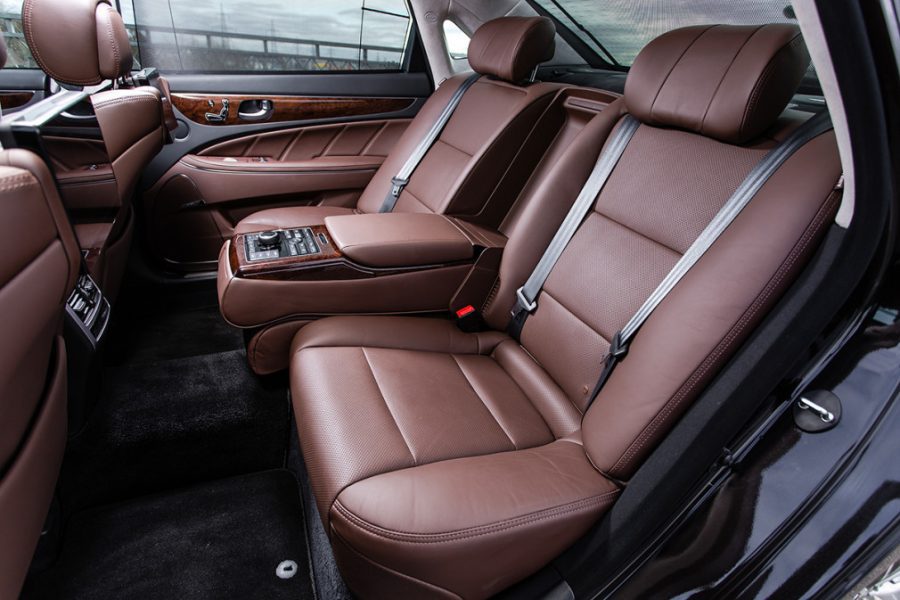
A few years ago, all Korean bosses drove archaic Hyundai Centennial sedans and looked quite decent. Centennial for Korea is like Toyota Crown Comfort taxis for Tokyo. Only wealthy Koreans almost never looked either at the hated Japanese products, or at the excessively expensive and almost killed by 200% duties in Europe. Finally, now they got a truly native executive car, and at once moved to it. And it's not just about duties. A little hypertrophied patriotism and self-esteem worked, multiplied by the qualities that the Korean sedan can really offer in the executive segment.
Equus managed to do what the well-deserved but misunderstood Volkswagen Phaeton could not. The Germans did not have the audacity to declare their sedan the closest relative of the Bentley Continental flying spur (although this is the truth), nor the courage to equip it with the latest technology in order to put their own Audi A8 among the competitors. The Phaeton turned out as if by accident, and recently it, rather outdated, as if apologizing, was quietly removed from the model line. Koreans, on the other hand, entered the segment cheerfully and with aplomb, and now they have also created a new brand - without history, but with a residence permit in the most ambitious market segment. It doesn't matter if they sold Equus at a loss, encouraging dealers to supply scarce Solaris. Sales policy is an internal matter.
